Items
Tag
Microscope
-

Drum Compound Microscope
The drum compound microscope is made of brass. The style was manufactured in France, Germany and England and sold throughout the United States and Europe. Many of the microscopes manufactured using this design were unsigned due to the huge quantities sold by various makers. The microscope consists of a body-tube suspended by a tubular base above a circular specimen platform. Coarse focus functions by moving the body-tube closer or further away from the specimen platform via a sliding mechanism operated by a thumbscrew. There is also a concave sub-stage mirror located at the bottom of the microscope. The "coffin-style" mahogany case has compartments for the microscope, slides and accessories. There was a small, decorative plaque on the top of the lid, however, it is no longer attached to the case. The case is secured via a lock and key; however, the key is not present with the microscope. -

Simple "West Patent London" Microscope
Many simple microscopes were made around the 19th century to the style of the "Society of Arts" Prize Pattern. Many used this design to create affordable microscopes, therefore very few were signed by the creator and the design differed depending on the manufacturer. The "Cary-Gould" style, simple microscope is made from lacquered brass and is case-mounted onto a fitted mahogany case. The pillar screws into the top of the lid which is permanently attached to the circular stage and arm. The objective lens can be used separately — to work as a simple microscope — or used together to function as a compound microscope. The sub-stage mirror is attached via a pin into the lower part of the pillar. The dissecting pin is attached via a pin to the stage. The mahogany fitted case is secured by two brass hooks on either side of the case. The interior of the case is lined with blue velvet and is organized into compartments to fit the disassembled microscope. -
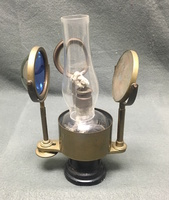
Microscope Lamp
The alcohol lamp has a brass circular fitting around the lower glass reservoir. The brass ring secures a magnifier, a blue-filtered condensing lens and a mirror to the lamp. The attachments can be adjusted by moving it around the lamp. -
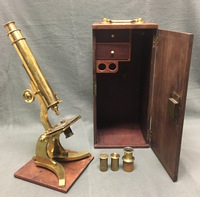
White and Barr Microscope
The compound monocular microscope is made from lacquered brass and mounted on trunnions. The microscope has a Y-shaped base which is mounted on a wooden platform. The microscope has coarse focusing via rack and pinion which is controlled by a thumbscrew located on the side of the support pillar. The support pillar is connected to the body-tube and the square stage is fixed. A polarizer is screwed into the bottom of the stage; however, there is no substage mirror present on the microscope. The fitted mahogany case has a brass carry handle. The two interior accessories drawers have ivory handles and there are two circular wooden cutouts to hold the objective canisters. The case has a functional lock but no key is present with the microscope. -

Drum Compound Microscope
The drum compound is made of lacquered brass. This style was manufactured in France, Germany and England and sold throughout the United States and Europe. Many of the microscopes manufactured using this design were unsigned due to the huge quantities sold by various makers. The microscope consists of a body tube suspended by a tubular base above a circular specimen platform. Coarse focusing is achieved via a sliding mechanism in which the body tube is moved closer or further away from the specimen platform. A bullseye condenser is attached to the front of the microscope which can be adjusted via the double-jointed arm. There is also a concave substage mirror located in the bottom of the microscope, which can be seen through a square cut out. The mirror can be adjusted by thumbscrews on either side of the microscope, however, the mirror is detached on one side. The "coffin-style" wooden case has compartment for the microscope and slides. The case is secured with two swing hooks. -

"Cary-Gould style" Field Microscope
The field microscope is made of brass and case-mounted onto a mahogany case which acts as the base. The pillar is secured into the lid of the case via a screw attachment at the bottom of the pillar. The stage is permanently attached to the pillar and coarse focusing functions by a rack and pinion which moves the stage closer or further from the objective. The arm is attached by sliding it into the top section of the pillar where it is secured by a thumbscrew. The objective lens are screwed directly into the end of the body-tube which can then be screwed into the arm. The stage has two clips that hold the specimen by placing the slide between the clip and the square stage. The sub-stage mirror is attached via a pin into the pillar. The mahogany fitted case has some marks and stains. The inside of the case is lined with blue velvet and has compartments to fit the dissembled microscope and accessories. The case is secured by two brass swing hooks on the sides. -
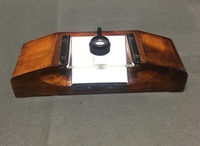
Simple Dissecting Microscope
The dissecting microscope is made of solid mahogany with tapered ends that form rests for the hands. The glass stage plate is beveled with a white glass plate located underneath that is placed at an 45 degree angle for illumination. The lens is held in a fitting which swings over the stage plate and slides up and down for focussing. This microscope style was used mainly to study small flowers and plants as well as small animals. -

"Cary & Gould" style Microscope
The "Cary-Gould type" microscope is a common variation of the design. The design came in three sizes and this microscope is considered a "medium." The microscope has a support pillar that screws into the top of the lid. The body-tube is screwed into the arm of the pillar. This design also allows for the microscope to used as a simple microscope by screwing the objectives directly into the arm. The coarse focusing functions via a rack and pinion mechanism which moves the circular stage closer and further away from the objective lens. The circular stage has a under-stage sprung slot which holds the slide and the specimen forceps are attached via a pin. The sub-stage concave mirror is attached via a pin into the support pillar. The microscope can be used as both a compound and simple microscope depending on whether the body-tube or objectives are used respectively. The fitted mahogany case has purple velour-lined interior. The case is closed via two swing hooks, however, one is missing. -

Drum Compound Microscope
The drum compound microscope is made of lacquered brass. The style was manufactured in France, Germany and England and sold throughout the United States and Europe. Many of the microscopes manufactured using this design were unsigned due to the huge quantities sold by various makers. The microscope consists of a body tube suspended by a tubular base above a specimen platform. The body tube is moved closer or further away from the specimen platform to focus via a sliding mechanism. There is also a concave substage mirror located in the bottom of the microscope, which can be seen through a square cut out. The mirror can be adjusted by thumbscrews on either side of the microscope. The thumbscrew for the rotation of the mirror has the word "France" engraved in it. The fitted case is designed along a "coffin-style" that is secured with two small swing hooks. One of the hinges that holds the top is broken. The case has a small compartment to hold slides or accessories. The inside of the case has a paper plastered on it that reads: "GROSSISSEMENT. 1 lentille....30 fois. -

Cary-Gould style Simple Microscope
The Cary-Gould style microscope is made of lacquered brass. The simple microscope has a circular support pillar that screws into the top of the case, which acts as the base. The coarse focusing is achieved by extending the arm higher or lower via a rack and pinion mechanism. The fixed stage is detachable to fit the microscope into the case and has two stage clips to secure the slides. Unusually, the microscope does not have a substage mirror. The mahogany case is fitted to hold the instrument. The case has sections to hold various accessories, and the inside of the lid is lined with purple velvet. The top of the lid has a brass fixture for the pillar to screw into. The case is secured with two swing clips. -
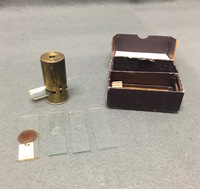
Pocket Handheld Microscope
The pocket simple microscope is made of lacquered brass. The microscope magnifies items 50 times linearly. The design is also known as a "universal" microscope and was popular from the start of the twentieth century. The simple design includes a singular ocular and the slides are held in place via a slot on the lower section of the circular body which is spring-loaded. These types of microscopes were manufactured in France or Germany and due to their low-cost, durability, and simplicity to use meant it was a popular instrument for hobbyists. The original box is made of cardboard and has two compartments to hold the microscope and the slides. The case also has instructions to use the instrument inscribed inside the lid. -

Drum Compound Microscope
The drum compound microscope is made from lacquered brass. The design of the instrument is French and was used by scientists and students in the field as it's compact size made it easy to use outside the laboratory. The focusing is done by moving the draw-tube closer or further away from the fixed circular stage. The substage mirror is one-sided and is plano-concave. The base is weighted in order to balance the microscope. -

Drum Compound Microscope
The drum compound microscope is made from lacquered brass. This design made the microscope easy to use in the field by scientists. The focusing is done by moving the draw-tube closer or further away from the fixed circular stage. The design is French and has a one-sided substage plano-concave mirror located underneath the stage. The base is weighted in order to balance the microscope. -

Stanhope Pocket Microscope
The pocket microscope is set in a bone frame. Invented by the third Earl of Stanhope, the Stanhope lens is moderately powerful and was used to inspect specimens or read small prints. This type of lens was used in "Stanhopes," small objects with micro-photographs inside to be viewed through the lens. These instruments were used mainly as novelty items. -

Coddington Microscope
The microscope is gold plated on brass. A Coddington magnifier is a magnifying glass consisting of a single very thick lens with a central deep groove diaphragm at the equator, thus limiting the rays to those close to the axis, which again minimizes spherical aberration. This allows for higher magnification than conventional magnifying glass, typically 10× up to 20×. Most single lens magnifiers are limited to 5× or so before significant distortion occurs. The drawback is that the diaphragm groove reduces the area seen through the magnifier. -
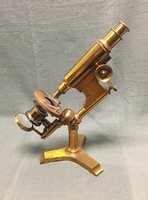
Bausch & Lomb Microscope
The monocular compound microscope has a tripod base with the arm and stage in a cradle joint. The stage revolves, and has two indexed swinging arms below the stage. These arms are dovetailed for the substage condenser, which has a wheel of stops and a swing out holder for a dark field disk (which is present,) and for the concave mirror, which can swing below or above the stage. It has a single nosepiece and on the arm, below the focus knobs, are the patent dates for October 1876 and October 1885. "Bausch & Lomb Optical Co" is engraved on the revolving stage. The microscope has a single draw tube which is nickel plated. This microscope is very similar to number 170 in Billings Collection, noting that it has a single nosepiece and a single draw tube. The case is in serviceable condition, but shows the signs of extensive use. There are cracks on the back, the bottom has a crude repair on the front under the door. The lock is complete and seems to be functional, but the locking tab has been removed from the door and a swinging home made latch secures the door closed instead. The key is present in the drawer in the case. The top handle is missing and there is a picture of a dignified man on a Tennessee Walking Horse pasted on the back inside of the case. -
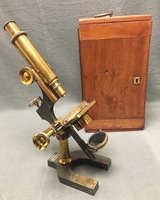
William Watson & Sons Microscope
The microscope is a "Edinburgh Model C" with mechanically stage. The microscope is engraved in block letters on the foot "W. Watson & Sons, 313 High Holborn, London." There is also a serial number "2754" on the side of the base. In addition, it includes a brass plaque attached to the foot, which reads as follows, “PRESENTED TO William Anstey BY HIS MOTHER, BROTHERS & SISTERS. In loving recognition of his untiring devotion TO THE WELFARE OF THE FAMILY, MARCH 1892.” Due to the fact that Watson did not take on this name for the firm until the year 1908, it would appear that the stage was added to this microscope as an accessory sometime after that year. A heavy solid Japanned brass Y-shaped foot supports a solid brass pillar at the top of which is a movable joint that joins the pillar to the stage, which in turn supports the limb of the microscope. This joint just below the stage allows the microscope to be tilted to any comfortable angle for viewing. It has a rack and pinion main focusing system and a thumb wheel micrometer fine focusing system via a spring-loaded lever system extending through the limb. Atop the main stage is a supplemental mechanical stage with dual thumb wheel “X –Y” controls extending to the side. The stage is engraved with the inscription, “W. Watson & Sons, Ltd., London”. The body-tube includes a draw-tube, which is engraved with various tube settings. An eyepiece (unmarked as to magnifying power) is found at the top of the body-tube. Under the stage is a swing-out brass housing for a condenser, but no condenser is present. Also under the stage is an adjustable stem with a nice adjustable plano-concave mirror. The mahogany case is of dovetail construction and is equipped with a brass carrying handle at the top. It accommodates the microscope and there is a wood rack inside the right side of the case that nicely accommodates the mechanical stage. -

Coddington Microscope
The Coddington lens was invented in 1829 by Henry Coddington. This microscope is made from brass and wood and contains a single lens with two curved sides and a groove cut around the middle of the lens which acts as a lens stop. The microscope offers a clear image from 1 inch away from the front objective lens. This microscope was used in the field by botanists and naturalists due to its small size, good magnification and portability. -

Charles Baker Compound Microscope
The brass, compound microscope was designed by the Ross pattern with a Y-shaped foot screwed to a mahogany board which slides into the case. The stand is the Baker #2 stand advertised in 1862. The coarse focusing is operated by rack work and fine focusing by thumb-wheel on the nose-piece. The circular stage has a centering bar that slides along the stage for positioning the specimen. Below the stage is an adjustable Abbe condenser that moves with its own rack work and adjusting thumb screws. The condenser has a slide out holder for filters and the substage mirror is concave and one sided. The microscope has three eye-pieces of different magnification and is signed on the foot "Baker, 244 High Holborn, London." The mahogany case is fitted and has compartments to hold the objectives and slides. -

Bausch & Lomb Compound Microscope
The monocular microscope has a cast iron horseshoe base. The pillar, cast as one piece, and the limb is made of iron and painted black. The brass arm supports the body-tube, which has a triple nosepiece. The coarse adjustment is by rack work, and the screw for fine adjusting is on top of the limb. Below the square stage are a swinging Abbe condenser, an iris diaphragm, and a concave substage double mirror. The microscope is signed: "Bausch & Lomb Optical Co. Rochester, N.Y." Serial number 104100 is engraved at the end of the tube. The wooden carrying box has a crack in the back of the box from top to bottom. The case has some signs of wear and tear with a lock without a key. -
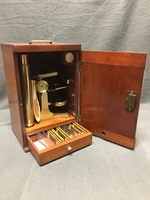
Marratt & Short Compound Microscope
Marratt & Short compound brass microscope is mounted on a wooden platform. The monocular microscope is signed on the stand "MARRATT & SHORT 63 King Willm Str. LONDON BRIDGE". Marratt & Short were opticians who offered sight testing and constructed artificial eyes as well as scientific instruments. The microscope has a Y-shaped foot, which stands on a wooden platform. The substage mirror is concave and attached to the lower limb of the microscope. The body-tube screws into an attachment on the top of the limb. The microscope focuses via a rack and pinion adjustment, operated by thumb screws on either side of the limb. The stage has a slide holder that can be adjusted via sliding. The microscope can be dissembled to fit inside the case. The mahogany case has a brass carrying handle, working key and lock, and interior slide drawers. -
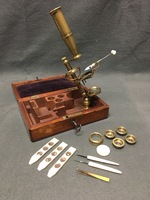
Cary-Gould Style Microscope
The small compound and simple monocular microscope retains its original gold lacquer. This Cary-Gould type microscope includes a fitted case which acts as the base. The microscope base is a ball and socket joint which is connected to the arm. The concave mirror is connected to the arm, and the body-tube screws into an circular extension of the arm. The limb mounted bulls-eye condenser and stage forceps are detachable and can be connected to the stage through small holes. The stage is focused by rack and pinion via a thumb screw located at the end of the body-tube. The microscope can be used as a compound microscope by using the body-tube and eye piece; however, the objective lenses can be screwed into the arm to change the function to a low-power simple microscope. The microscope can be disassembled and fit into the case for easy portability. The original mahogany box has a functional lock and key. The microscope arm is attached to the inner right side of the case. -

Stanhope Microscope
The microscope is set in turned ox bone handle with small lens. Invented by the third Earl of Stanhope, Stanhope lens are moderately powerful and were used to inspect specimen as well as reading small print. This type of lens was used in "Stanhopes," small everyday objects with micro-photographs inside to be viewed through the lens. -
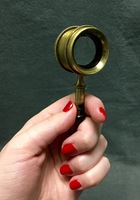
Coddington Microscope
Invented in 1829 by Henry Coddington, this brass and wooden microscope is made up of a single lens with two curved sides and a groove cut around the middle of the lens which acts as a lens stop. The microscope offers an image from 1" of the front objective. This microscope was used in the field by botanists and naturalists due to its small size and good magnification. -

Sentry-Box Type Microscope
The "Sentry-Box" type of compound microscope is one of several types of instruments, all made of wood and decorated cardboard, manufactured in the toy district of Bavaria, Germany (near Nuremberg.) The main styles included a Culpeper-type, Sentry box-type, Solar, and Side Pillar-type. These monocular microscopes were all made in the same style with only minor variations in the decorations for nearly half a century. This microscope is signed by "JFF" within a heart, one of a few known signatures often appearing on these instruments.
